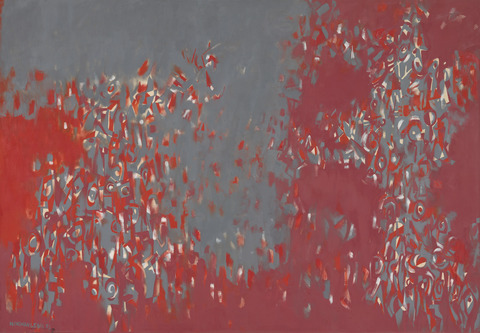
Yale University Art Gallery
In a bright room on the third floor of the Yale University Art Gallery hangs an untitled, unheralded and unbounded 1973 painting by Norman Lewis. A black artist working in New York City during an era of racial upheaval, Lewis continues to receive less attention than his abstract expressionist contemporaries like Jackson Pollock and Mark Rothko. Lewis’ painting shares a kinship with Pollock’s work in its frenetic abstraction and with Rothko’s in its layered light and color. But this painting represents a style entirely Lewis’ own, straddling the abstract and the figural, the political and the personal. It is a gyre of brushstrokes, and at its center churns a red and gray enigma.
These two colors dominate the epic 4.5-by-6.5-foot canvas. Applied in brusque strokes, the bottommost layer of steely gray occasionally approaches mauve in its unevenness. A burgundy red overtakes the canvas’ upper right corner, where a parade of vague figures draws the viewer’s eye. Standing out in a vibrant crimson accented with white, these geometric figures variously resemble calligraphy, fingerprints and people flattened by Cubism.
Composed as a spiral, the painting generates enormous kinetic energy as its ambiguous figures dance across its frame. The procession sweeps the viewer down the right side of the canvas, along its red bottom, and up its left side. Here, the red reignites into the crimson found in the rightmost figures. As the color’s heat intensifies, so do the figures. They lose their resemblance to the natural and unfurl into wholly abstract shapes. When they reach the painting’s cool gray center, they dissolve into flecks of paint. They plummet, like embers, to the bottom of the canvas.
The painting’s lack of a title deprives the viewer of a potential code with which to decipher its meaning. Lewis likely gave it a title, but, as with many of his paintings, it has been lost. Other paintings of his which feature the colors red and white, as this one does, abstractly depict the Ku Klux Klan. With this subject in mind, one can interpret the angularity of the painting’s red and white figures as representing Klan regalia’s pointed hoods. The red conjures blood, but mainly fire — that of burning crosses, of lynchings, of church bombings. But here, the Klan figures seem to burn in their own flames before disintegrating at the painting’s center. This inferno is even apocalyptic, a kind of hellscape.
This interpretation, of course, is speculative. While Lewis was active in protesting racial injustice, he also resisted creating purely political art. The genius of the painting, and the unintended blessing of its lost title, arises from its ability to encompass the political and the personal. In his private notes, Lewis wrote, “The real function of art is to express feeling and transmit understanding.” The painting’s beauty comes from the emotion a viewer can experience regardless of the exact subject it depicts.
For me, another kind of blaze comes to mind which Lewis may not have intended but which his abstraction nonetheless allows. In Exodus, God appears to Moses in a burning bush and calls to him. Alone and afraid, Moses answers, “Here I am.” I feel this painting is Lewis’ Moses moment. Like Moses, Lewis was a member of a persecuted minority in a kind of exile who possessed prophetic power. They experienced more burning than just the bush: the burning shame of discrimination, the burning desire for freedom, the burning rage of injustice. The viewer, via art, feels this emotional immolation. Here I am, Lewis says in the painting. Here we are — swirling, glowing, falling.
Joshua Baize | joshua.baize@yale.edu .







